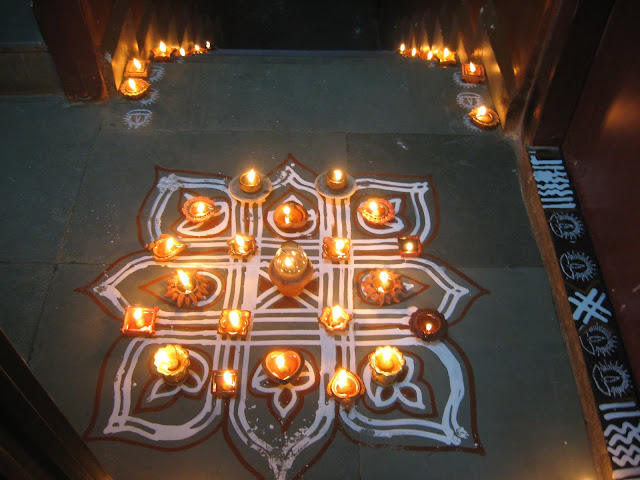The city of Kashi is filled with temples, big and small, old and new. There are temples at every corner, and you never know where you will stumble upon a small shrine. There are idols beneath what remains of trees (there are hardly any trees any more within the core area of the city), there are saffron covered forms resembling deities which seem attached to walls, an especially incongruous sight when the idol itself appears to be old, while the wall is evidently new…. And there are surprisingly large temples rising from what appear to be a bunch of houses. The city is sometimes colloquially said to be as old as time, and some of the shrines and temples are said to date back to times unknown, at least the deity itself, if not the structure. Not much remains of the ancient structures anyway. The city has seen more than its fair share of good and bad times. It has seen the heights of grandeur, and the lows brought about by destruction. The city that exists today has grown so haphaza...
Karthikai could possibly be called the South Indian equivalent for Diwali. While Diwali for us means Ganga-snanam (purifying bath), new clothes and of course, crackers, it is Karthikai for which all the lamps come out in full force... especially the earthen ones! The festival is celebrated over 3 days - the first day is called Bharani Deepam, the second is called Annamalai Deepam, and the third is Sarvalaya Deepam. The second is the main day, when a huge lamp is lit on the holy mountain of Thiruvannamalai, symbolising the form of Shiva as a never ending pillar of light (Yes, that's another long story, one I dont have time to write right now!).
In our south-Indian dominated colony, Karthikai arrives with much fanfare, with special pujas in the temple, which I have never attended, thanks to having to celebrate the festival at home, and stay guard over the lamps, which have to be constantly replenished with oil! But more interesting are the beautiful red and white kolams decorating every house and the beautiful lamps which light up the usually dark passages. I have earlier written posts on Karthikai, mentioning different types of lamps, as well as my own celebrations, and this year, here are some photographs once again from the celebrations at my house.....
Welcoming you to my home on the first day.....
 |
| A free hand kolam... |
 |
| Now all lit up! |
 |
| Those aren't the only lamps.... |
 |
| Some more lamps in the corner. |
 |
| One of my favourites.. this one lasts for hours and hours! |
 |
| Another pretty one... |
 |
| The most important part of the festival - the prasadam! Pori urundai!!! Samhith must have eaten a dozen of these!! |
And now for the second day....
 |
| Another free hand effort! |
 |
| All lit and ready! |
 |
| Kept inside on a plate... |
 |
| Another set |
 |
| Samhith bought this one at his school fair! |
 |
| And finally, this was how the approach to our house looked! |
As you can see from these pics, we effectively blocked the path to not just our house, but also the neighbouring ones with our lamps! And this was just the beginning, for even the others lit their lamps a little later....though not as many as these!!! Apologies too all who had to navigate this flaming stairway for two whole days! Now to pack up all these lamps (more than 65 of them, yes, i counted!) for next year! Sigh!
Related Posts:
- Karthikai at home - All lit up!
- Karthikai 2009 - Annamalai Deepam
- Karthikai 209 - Bharani Deepam
- Karthikai 2009 - A variety of lamps
Beautiful festival.
ReplyDeletewww.rajniranjandas.blogspot.com
The lamps look so enchanting and of course I had never heard of this before!
ReplyDeleteThanks!
ReplyDeleteThanks Mridula! i guess there are so many festivals in india, that none of us can possibly know abt all of them!!!
ReplyDeleteBeautiful Anu, Usually I dont' celebrate this festival as our karthik masa is along with diwali.But my neighbour yesterday coaxed me and I too decorated my house with diyas. It was a nice feeling.
ReplyDeleteTHanks chitra! here, karthikai is much more important than diwali ! my in laws light just a couple of lamps for diwali... at my mom's place we used to celebrate both! and for karthikai, i used to draw elaborate kolams inside the house and light lamps in a pattern! cant do that now till samhith grows up! glad to hear that u enjoyed it this year!
ReplyDeleteBeautiful! This is so new to me Anu. So you celebrate Diwali 2 times a year, I am jealous!!
ReplyDeleteWonderful shots of Rangoli and glittering Diyas.
Nice to about this festival .
ReplyDeleteNice to know about this festival .
ReplyDeletelovely lamps and light show!
ReplyDeleteBeautiful, Anu! I know abt this festival but never celebrated at home. Who did the kolams? Pretty designs. I do with dry powder, not the wet ones. Just don't know how to do it. :P
ReplyDeleteAh! Very beautiful indeed! I didn't know about this festival, thanks for introducing with such lovely writeup!
ReplyDeleteThanks Team G Square!!
ReplyDeleteMe, Nisha! I love drawing kolams, esp the ones with the wet flour!
ReplyDeleteThanks a lot, Summi!
ReplyDeleteThanks so much, Sowmya!
ReplyDeleteNice blog with good and interesting information. I always keep in touch with your blog and going to bookmark also.
ReplyDeleteThanks